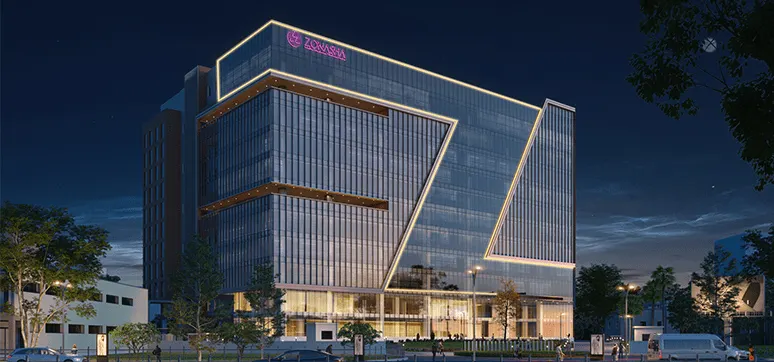In the fast-paced urban landscapes of today, where the rhythm of city life reverberates, the necessity for peaceful and tranquil architectural spaces has become increasingly apparent. Acoustic comfort, often overlooked yet crucial for both well- being and productivity, stands as a fundamental consideration in contemporary architectural design. The façade, serving as the intermediary between the external environment and the interior sanctuary, holds significant sway in shaping the acoustic ambience within structures.
This article embarks on a journey into the intriguing realm of façade materials and installation techniques, exploring their role in optimizing acoustic comfort in modern constructions. From conventional materials with enhanced Façade Materials and Installation Technologies for Better Acoustics mass characteristics to cutting-edge sound-absorption technologies, this piece will delve into the myriad of options available to architects, designers, and builders aiming to craft spaces that blend harmoniously with their auditory surroundings as well as their visual aesthetics.

The importance of acoustics in architectural design cannot be overstated. Unwanted noise stemming from traffic, construction activities, or other sources can disrupt concentration, impede communication, and adversely affect overall well-being. Moreover, internally generated noise, such as that from HVAC systems or human activities, exacerbates the issue. Consequently, addressing acoustic challenges is imperative in creating environments conducive to productivity, relaxation, and a sense of serenity.
Façade materials play a pivotal role in mitigating noise infiltration from external sources. By opting for materials with superior sound insulation properties, architects can establish a barrier between the interior and exterior environments, thereby minimizing the impact of external noise on occupants. Furthermore, innovative materials like acoustic insulation panels or perforated metal panels offer targeted solutions for managing reverberation and echo within enclosed spaces, thereby enhancing acoustic comfort.
Installation technologies also wield significant influence in optimizing acoustic performance. Techniques such as decoupling, which isolates building elements to reduce sound transmission, and active noise control systems, which utilize advanced technology to counteract ambient noise, present effective means of enhancing acoustic comfort in buildings. Proper sealing and weather stripping of a building ensures components ensure airtightness, further mitigating the ingress of external noise.
By embracing the latest advancements in acoustic design, architects and designers can fashion spaces that not only captivate the eye but also provide solace to the soul, offering a refuge of tranquillity amidst the urban commotion.
UNDERSTANDING ACOUSTIC DYNAMICS IN BUILDINGS
Before delving into the specifics of façade materials and installation techniques, it is imperative to comprehend the fundamental principles governing acoustics within buildings. Such comprehension is essential for crafting spaces that prioritize comfort and productivity. Acoustics in buildings pertain to the behaviour of sound waves within enclosed spaces, influenced by diverse factors such as architectural layout, material selection, and activities conducted within.

External sources of noise, including traffic, construction, and urban development, pose significant challenges to indoor environments. These noises can permeate buildings through windows, walls, and doors, disrupting concentration, communication, and overall comfort. Additionally, factors such as proximity to highways or industrial zones can exacerbate noise levels, impacting the quality of life for occupants.
Internally generated noise, encompassing HVAC systems, mechanical equipment, and human activities, further contributes to the acoustic dynamics within buildings. Inadequately insulated walls, floors, and ceilings can facilitate noise reverberation and echo, creating discomfort and distraction for occupants. Moreover, open-plan layouts, while fostering collaboration, can also lead to elevated noise levels if not properly managed.
Architectural design assumes a crucial role in mitigating the impact of both external and internal noise sources. Strategic placement of rooms, corridors, and building elements can minimize noise transmission and optimize sound quality within different areas of a building. Additionally, the selection of appropriate materials endowed with sound-absorbing properties is vital for controlling reverberation and enhancing acoustics.

Materials such as acoustic insulation panels, mass-loaded vinyl, and double-glazed windows are commonly employed to ameliorate sound insulation and reduce noise transmission. These materials absorb sound waves, preventing them from bouncing off surfaces and causing reverberation. Green façades, integrating vegetation on building exteriors, can also function as natural sound barriers, thereby further enhancing acoustic comfort.
Advanced installation technologies, such as decoupling systems and active noise control, offer additional tools for managing acoustic dynamics in buildings. Decoupling techniques entail isolating building elements to minimize sound transmission between them, while active noise control systems utilize sensors and speakers to detect and counteract ambient noise in real time.
In conclusion, comprehending acoustic dynamics in buildings is crucial for creating environments that promote well-being and productivity. By addressing external and internal noise sources through architectural design, material selection, and advanced installation technologies, architects and designers can optimize acoustic comfort within buildings. Ultimately, a holistic approach that considers the unique characteristics and requirements of each space is pivotal in achieving optimal acoustics and enhancing the overall quality of life for occupants.
FAÇADE MATERIALS FOR ACOUSTIC ENHANCEMENT
- Mass-Enhancing Materials: Dense materials like concrete, brick, and stone possess inherent mass that effectively absorbs and dissipates sound energy. When integrated into façade construction, these materials serve as robust barriers against external noise intrusion, shielding indoor environments from unwanted sound. Incorporating mass-enhancing materials into façade assemblies significantly enhances sound insulation properties, fostering tranquillity and acoustic clarity within buildings.
- Acoustic Insulation Panels: Engineered to absorb sound energy, acoustic insulation panels offer tailored solutions for controlling noise levels within buildings. Comprising of materials such as fibreglass, mineral wool, and foam, these panels mitigate reverberation and echo, thereby enhancing acoustic comfort and clarity. By integrating them into façade assemblies, architects and designers can achieve remarkable improvements in acoustic performance, creating serene indoor environments conducive to concentration and relaxation.
- Double-glazing Systems: Windows, often perceived as weak points in building envelopes, can be fortified against sound infiltration through double or triple-glazing systems. These systems feature multiple layers of glass separated by air or gas-filled gaps, providing enhanced acoustic insulation. Laminated glass with an acoustic interlayer further augments sound attenuation, ensuring tranquillity within indoor spaces while facilitating visual connectivity with the external environment.
- Perforated Metal Panels: Blending functionality with aesthetics, perforated metal panels offer an elegant solution for acoustic optimization. By strategically ncorporating perforations of varying sizes and patterns, these panels scatter and absorb sound waves, mitigating reverberation and controlling noise levels. Customizable in design and highly effective in performance, they constitute an integral component of acoustically superior façades, enhancing both visual appeal and auditory comfort.
- Green Façades: Nature, with its innate tranquillity, holds immense potential for mitigating noise pollution. Green façades, adorned with lush vegetation, serve as natural sound absorbers, reducing noise levels within buildings. Beyond their acoustic benefits, they contribute to environmental sustainability, thermal regulation, and aesthetic enhancement, fostering a harmonious integration of built and natural environments.
INSTALLATION TECHNIQUES FOR EXCEPTIONAL ACOUSTICS
Decoupling Systems: Decoupling methods rely on isolating structural elements to minimize the transmission of sound vibrations. Utilizing resilient mounts, floating floors, and suspended ceilings, these systems effectively prevent the spread of structural noise, thereby enhancing overall acoustic performance. By reducing direct contact between building components, decoupling systems create tranquil indoor environments conducive to concentration and relaxation.

Sealing and Weather Stripping: Maintaining airtightness is crucial for combating both air infiltration and sound transmission. Various weather-stripping materials, such as silicone seals, rubber gaskets, and acoustic caulks, are employed to create impermeable seals, safeguarding indoor spaces against external noise intrusion. Proper sealing of building envelope components ensures clarity and comfort in acoustics, thereby enhancing the overall quality of indoor environments.
Soundproofing Membranes: Applied to structural elements like walls and floors, soundproofing membranes offer a robust defence against airborne noise. These flexible membranes dampen vibrations and impede sound transmission, thereby reinforcing sound attenuation within the building envelope. By improving the acoustical integrity of building assemblies, soundproofing membranes contribute to creating tranquil and harmonious indoor environments.
Active Noise Control Systems: Leveraging advanced technology, active noise control (ANC) systems provide real-time mitigation of unwanted noise. Employing microphones and speakers to detect and counteract ambient noise, ANC systems offer tailored solutions for enhancing acoustic comfort and fostering serene indoor environments. Whether in open-plan offices or residential dwellings, ANC systems provide versatile solutions for creating tranquil and harmonious indoor environments.
CONCLUSION
In summary, achieving optimal acoustic performance in buildings necessitates a holistic approach that integrates both façade materials and installation technologies. By leveraging sound-absorbing materials, double-glazing systems, green façades, and innovative installation methodologies, architects and designers can create spaces that prioritize tranquillity, productivity, and well-being. Enhancing acoustic comfort not only enhances the occupant experience but also reflects a commitment to creating sustainable, user-centric architectural environments. As the demand for acoustically superior buildings continues to grow, embracing the latest advancements in façade materials and installation technologies becomes paramount in shaping the future of architectural design.














